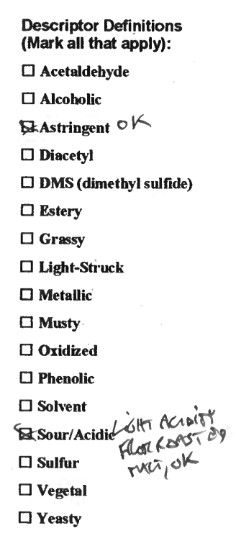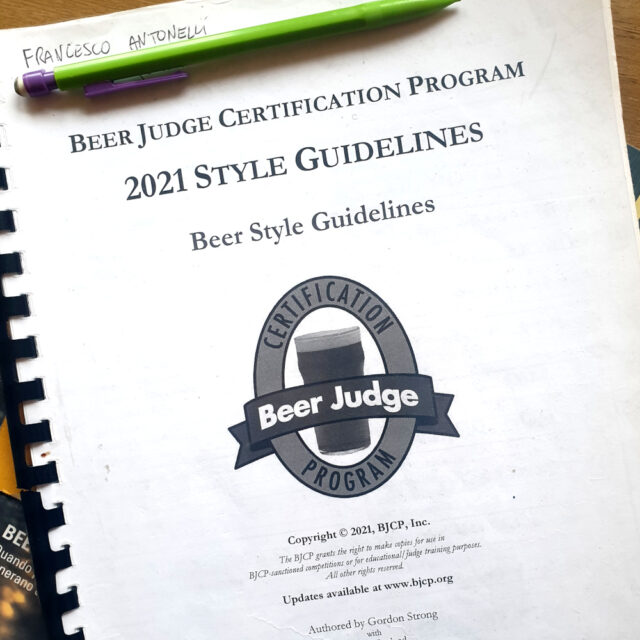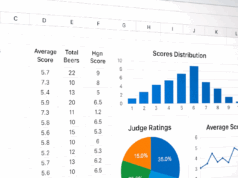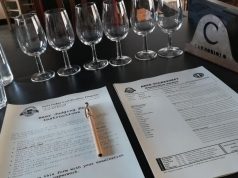I was given my first set of Tasting BJCP Exams to grade in February of last year (2024). I am currently grading my eleventh set after almost a year. I took the Tasting Exam again last year and received a score of 91/100. This moved me up to Master rank.
The quality of scoresheets might vary. Some are quite terrible, while others are better. As far as I’ve been able to tell, the extremely good ones are rare. Sometimes I wonder why some people choose to take this test if they didn’t even bother to go over the fundamentals.
Even the better-performing scoresheets often have trivial mistakes. It always surprises me that I find them so often because some of them are so simply fixed.
Use of ranges (even proctors do that!)
The BJCP guidelines provide ranges for aroma, flavour, mouthfeel, and appearance. Since they are meant to describe beer styles rather than individual beers, this makes sense.
The purpose of BJCP Scoresheets is to characterize a beer, not the style category. The aroma of a beer cannot be described as “low to mid malt aroma” since it is impossible for a beer to have two levels of strength simultaneously. That is basic physics. It ought to be obvious.
Nevertheless, I often see beer descriptions on scoresheets that make extensive use of ranges. I noticed that a number of National-level proctors also use them. It truly got to me. It should be so clear, yet it’s clearly not.
The use of ranges to describe a beer is illogical. The beer color shouldn’t be described as “yellow to deep gold“, try instead something like “deep yellow color, bordering on gold“. Instead of “low to none hop aroma“, try “very low hop aroma, almost impercetible“.
Ranges will negatively impact the Descriptive Ability score. However, utilizing ranges will also result in lower Perception Scores since the grader will not be able to match them with the quantifiers provided by the exam proctors.
Waste of spaces in the Overall section
The overall section of the scoresheet should not be used to recap the most important features of the beer. They should have already been covered in the other scoresheet’s sections. There is really no need to duplicate them.
In the Overall section you should provide:
- Feedback on the beer’s pleasantness. A beer could be tasteful, delicious, or challenging to drink.
- Technical feedback. Technical comments about off-flavors and the brewing process, along with suggested fixes.
- Style feedback. This could be challenging. You are required to highlight the key aspects of the beer that fit (or don’t fit) the style guidelines.
This already crams a lot of information into the little space designated for the overall impression. Reiterating what you already stated in the other sections will take up valuable space for no reason. Don’t do that.
Use the space you have been given wisely. Comments like “Thanks for sending this beer!” or “Keep on brewing!” are pointless. This is not a competition; it’s an exam.
The picture below shows the Overall part of a BJCP scoresheet I wrote. I got a Master score on this feedback (the beer was an American Stout).
Listing tons of descriptors without intensities
Scoresheets at the National or Master level should provide a lot of descriptive detail. In a previous post, I discussed how to increase your vocabulary related to beer (link).
However, I frequently come across a lengthy list of descriptors without relative intensities while evaluating exam scoresheets. While this could be sufficient to obtain a National score (most likely, Low-National) in Descriptive Ability, it won’t be enough to move it up to the Master rank.
It is challenging yet essential to elaborate on descriptors strengths and relate them to one another in order to convey the complex aroma that beers often have.
Instead of writing “Mid malt aroma, bready, bread crust, bread crumbs, toasted bread”, try something like “Mid malt aroma with a prominent bread crust note upfront, light nuances of bread crumbs, and a light touch of baked toast in the background“.
Avoid writing lengthy descriptor lists. With accurate phrasing, less really is more.
Don’t repeat yourself in the Flavour section listing the same descriptors of the Aroma. Try to highlight what changed compared to the nose. Describe the aromas that come forward and the ones that are less apparent. Often a citrus aroma feels kind of sweet in the nose but sharper in the aftertaste when the bitterness of an IPA kicks in.
The picture below shows the Aroma part of a BJCP scoresheet I wrote. I got a Master score on this scoresheet for Descriptive Ability (the beer was a Czech Premium Pale Lager).
 Not addressing all the components in each section
Not addressing all the components in each section
While grading exams, I often find myself penalizing completeness because the examinee forgets to describe all the characteristics listed under the title of each section. This shouldn’t be that hard; you just have to write something for every word listed.
Not addressing all the aspects of each section will reduce your score on Completeness, which is the most simple score to bump up to Master level without much effort. You just need to pay attention.
Neglecting to mention a characteristic of flavor or aroma will also affect the Perception score. A missing descriptor can’t be matched to the proctor’s.
The picture below shows the Flavour part of a BJCP scoresheet I wrote. I got a Master score on this scoresheet for Completeness (the beer was a British Golden Ale). Flavour decriptions are tricky. In this one, I almost forgot to address the overall balance.
Using quantifiers that are not specific
Always quantify the intensities with specific words. Don’t write “some esters“, “obvious hops aroma“, “apparent malt aroma“, “dominated by hops aroma“. Some, obvious, apparent, dominated are not quantifiers.
Use the regular ones: high, mid-high, mid, mid-low, and low. “A hint of” or “a touch of” could also be effective. “Dominated by hops aroma with high intensity notes of…” is an alternative. Your description should always include a quantifier.
Phrases like “this beer has prune esters” or “esters are appropriate” are devoid of quantifiers. Your Perception and Descriptive Ability scores will suffer as a result.
It seems trivial, but you woulnd’t believe how frequently I found missing quantifiers in the scoresheet I graded.
Don’t forget to check the checkboxes!
There are two of them, you need to check them both.
The one on the bottom of the Scoresheet is not difficult to fill in but is easy to forget. I suggest checking them again rapidly at the end of the exam. It will only take a few seconds.

The one on the left is more challenging as it includes descriptors in addition to off-flavours. Since most examinees forget to check the alcoholic, astringency, esters, and phenols checkboxes, I would advise you to tick them as you write and to always double-check them before passing to the next beer.
You can indicate whether or not the descriptor matches the style. It’s not mandatory, but it will be considered a style feedback (which is a good thing).








Can you clarify if the BJCP grading guide really ask grader to deduce points if examinee use ‘range’ to describe?
I really don’t think that ‘yellow to deep gold’ is fuzzy or illogical compared to’deep yellow color, bordering on gold’. it’s a graident and people perceive differently. how is it possible for a person to identify a color with a fixed color descriptor like RGB (255,204,0) ? And even the same for flavor and aroma, and how is ‘medium to low’ different than ‘medium low’?
and one more thing, the exam cover letter ask examinee to write the scoresheet ‘as if they are in a competion’, i don’t know if writing encourgement is deductive. I even think that’s a must.
Hi Simba. “From low to medium” represents a range, whereas “medium-low” is a specific point between low and medium. The same applies to the color range. Clearly, no human being can identify a color, aroma, or flavor with extreme precision. Writing “medium” is already vague enough but at least it places the perception at a specific point within the range; writing low TO medium is not. The use of ranges is considered a mistake, so much so that the grader is required to flag it, if present, in the final error table you find in the RTP.
As for encouragements, no one is penalized for writing them in an exam scoresheet, but they take up valuable space that could be used for other assessments that might actually increase the score. What is evaluated positively, instead, is making an effort to maintain a polite tone and always including some positive remarks about the beer. Writing stuff like “good try, keep brewing!” is not going to give you more points at the exam.
Thank you for your reply! It is very useful!
Hey Frank,
Thanks for sharing those tips! I believe it is very helpful for people who want to score a 90+ in tasting.
Echo a lot in the section of “Instead of writing “Mid malt aroma, bready,…”. That is my current approach to create a scoresheet. I believe that would help my Descriptive Ability, which is my biggest weakness according to my last RTP (all 6 in national ranges).
Could you elaborate more on “Don’t repeat yourself in the Flavour section listing the same descriptors of the Aroma.”? It would be great if you can share the flavor section of Czech Premium Pale Lager so we can learn more.
Thank you!
On the palate, aromas are rarely identical to those on the nose. They may show different intensity, or be perceived differently (grapefruit on the nose easily turns into grapefruit zest on the palate), and slightly different aromas may emerge through the retronasal passage. There are certainly common points, but it often happens that one reads the exact same description for nose and palate, with aromas appearing in the same sequence and intensity. That shows limited descriptive ability.
Thank you! That makes a lot of sense. I believe what I have to do is to increase my food-related vocabulary bank since English is not my first language.
A quick follow-up on Descriptive Ability: I judged a flight of Munich Helles last night and found it quite challenging to generate a series of descriptors for aromas and flavors at very low intensity. In Helles, for example, malt and hop character are typically subtle and straightforward (white bread, dough, light spice, floral). Do you have any tips for handling these light-intensity aromas and flavors?
You’re not forced to generate descriptors; in this case it’s normal not to find too many aromas. You can just try to describe in more detail what you do perceive. You could say something like: very light grainy aroma with light nuances of freshly baked bread in the background. As it warms up, a soft whiff of bread crust. Very light herbal hops, reminding of fresh-cut grass with a touch of sage. Fresh vibe, delicate aromas.
Something like that.
I prepared for the exam by building a set of descriptive sentences, taking inspiration from online beer reviews, articles, and also using websites like https://www.wordhippo.com/
to look for synonyms. Once I had built the framework of vocabulary, it became easier to fit in nouns and adjectives more smoothly. Believe it or not, now I actually find it harder to describe beers in Italian (which is my native language) than in English!
I also prepared for the exam writing about imaginary beers so that I could do that early in the morning before goint to work 🙂
Thank you so much! Imaginary beer is quite interesting to me. I’ll give it a try sometime but I’ll probably prefer actual beers.
Me too! But not in the early morning…
I’m working on my first grading assignment for the tasting exam! While grading other exams, I went back and graded my own exam and compared it to the RTP. I have a couple of questions on how I could improve my scoring and examing approach:
1. Overall Impression – My current approach starts with general drinking pleasure (e.g., “a good and easy-drinking beer”), followed by overall improvement suggestions (e.g., “with a few tweaks, this could be a 40+ beer”). Then I include comments on style accuracy, flaws, and “how to make it even better” (usually suggestions like increasing complexity or intensity). I was wondering if this is a good structure, and whether the “how to make it even better” section adds value since it’s not specifically required in the grading rubric.
2. Descriptive Ability Rubric – The scoresheet guide mentions “a total of 22 opportunities to use descriptive adjectives or phrases.” However, I feel there are actually more opportunities than that. From your article, it seems that to reach a 90+ or 95+ level, detailed descriptions of medium+ intensity aromas/flavors are key (which I completely agree with), but that level of detail isn’t clearly reflected in the rubric. Right now, I don’t have a very quantifiable way to evaluate descriptive ability, and it seems to overlap somewhat with completeness. Could you share your thoughts on how to better assess this?
Thanks in advance for your time and insight!
I imagine by “Overall Impression” you mean the feedback evaluation. In that case, your approach seems generally correct, but we also need to assess the consistency between what’s written and the overall evaluation of the beer, as well as the technical accuracy of the suggestions.
Feedback can also appear in other sections of the scoresheet, not necessarily only in the “Overall” one. Moreover, I always check the consistency of the suggestions with the checkbox in the bottom left: unless a beer has been rated as perfectly in style and flawless (and unless it got a45+), there should be some feedback for improvement.
As for descriptive ability, I’ve never followed the logic of counting adjectives. I think it’s extremely limiting and misleading. I generally use the examples described in the “C. Descriptive Ability” section of the BJCP Scoresheet Guide as a general reference for grading Descriptive Ability (i.e. “a Recognized judge might add a descriptive adjective, stating that it has an “American hop aroma,” while a Certified judge may also note the intensity and write that it has a “moderate American hop aroma”).
In any case, ask your Lead Grader , they’ll surely be happy to help you.
Happy grading!